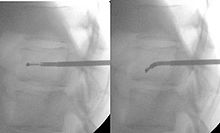Radio frequency ablation
The high-frequency ablation (Syn .: radio frequency ablation , RFA, or thermal ablation ) is a medical method for the local destruction of tissue. With high-frequency ablation, an applicator is inserted into the tissue and thermal necrosis (heat destruction) is generated here by the heat generated by the high-frequency current.
Radiofrequency ablation is used in various forms of medical therapy, such as: B. the treatment of cardiac arrhythmias , the destruction of liver metastases or the treatment of uterine fibroids .
Mode of action
The devices available on the market have different designs, depending on the manufacturer, with the aim of creating the largest possible and controlled zone of necrosis . RITA / Angiodynamics uses thin spreading electrodes and a 460 kHz generator with an output of 250 watts. Radionics uses rod-shaped, cooled electrodes and pulsed 480 kHz waves, at max. 200 watts of power . So far, the advantages and disadvantages of the systems have been balanced. Approx. 2.4-2.8 cm tissue areas can be destroyed per electrode position. About 1 ampere current flows. After 12 to 20 minutes, the tissue immediately adjacent to the electrode will char with formation of gas; this increases the electrical resistance and impedance and the transfer of energy comes to a standstill. Sonography or computed tomography is used to check the position of the probes .
Use in cardiology
In high-frequency ablation in the treatment of cardiac arrhythmias , the original location of the arrhythmia to be treated is located with a catheter as part of an electrophysiological examination (EPU) and heated by the delivery of electricity. This creates a scar that no longer has any electrical activity.
Use for metastasis treatment
In the treatment of liver metastases (tumor settlements in the liver ), high-frequency ablation is increasingly being used as an alternative to liver part removal. Advantages of radio frequency ablation are:
- Minimally invasive application possible: The treatment can often be applied by puncturing through the skin (i.e. without surgery)
- Repeatability: High-frequency ablation can also be used after previous liver surgery or if metastases occur repeatedly
- Tissue-saving: Due to anatomical conditions, an operation on liver metastases often requires removing a part of the liver that is much larger than the metastasis. With high-frequency ablation, only the metastasis itself is destroyed with a safety margin of 10 mm.
There is currently no larger prospective randomized study comparing high-frequency ablation with resection of liver metastases. The direct proof of the cancer therapeutic safety of the method has not been provided. However, the data available to date suggest that these forms of therapy are equivalent in terms of cancer-therapeutic safety.
When tumor cells migrate into the bones, the spine is often affected. In this case, severe pain and an increased risk of breakage occur, especially in the lumbar and thoracic spine , because the metastases impair the stability of the bone. In the treatment of vertebral body metastases (tumor settlements in the spine ), radiofrequency ablation has recently been used as an additional method for removing the metastases, in addition to radiation and / or chemotherapy .
Coblation
Coblation , from controlled ablation (manufacturer's name, for example "controlled ablation") is a variant developed in 2003 by the Californian company Arthrocare , in which temperatures only up to 70 ° C are reached. It is mainly used by ear, nose and throat specialists , e.g. B. for tonsil surgery . However, according to the studies presented so far, it is not superior to other methods.
Literature and individual references
- ↑ Hans Brölmann, Marlies Bongers, José Gerardo Garza-Leal, Janesh Gupta, Sebastiaan Veersema: The FAST-EU trial: 12-month clinical outcomes of women after intrauterine sonography-guided transcervical radiofrequency ablation of uterine fibroids . In: Gynecological Surgery . tape 13 , 2016, ISSN 1613-2076 , p. 27–35 , doi : 10.1007 / s10397-015-0915-3 , PMID 26918001 , PMC 4753243 (free full text).
- ↑ angiodynamics.com
- ^ Joachim Boese-Landgraf: Regional tumor therapy . Springer, 2003, ISBN 3-540-41762-1 , pp. 193– ( google.com [accessed August 13, 2011]).
- ^ R. Bornemann et al .: Clinical Aspects of the Problem of Vertebral Metastases, Possibilities of Modern Treatment Methods, Considering Especially Radiofrequency Ablation. In: Z Orthop accident. Volume 152, No. 4, 2014, pp. 351-357.
- ^ Robert Koch Institute, Center for Cancer Registry Data. Cancer in Germany. On the Internet: www.Krebsdaten.de/; As of December 13, 2013.
- ↑ arthrocare.com ( Memento of the original from December 16, 2011 in the Internet Archive ) Info: The archive link was inserted automatically and has not yet been checked. Please check the original and archive link according to the instructions and then remove this notice.
- ↑ R. Mösges, M. Hellmich, p Allekotte, K. Albrecht, M. Boehm: Hemorrhage rate after coblation tonsillectomy: a meta-analysis of published trials. In: European archives of oto-rhino-laryngology: official journal of the European Federation of Oto-Rhino-Laryngological Societies (EUFOS): affiliated with the German Society for Oto-Rhino-Laryngology - Head and Neck Surgery. Volume 268, Number 6, June 2011, pp. 807-816, ISSN 1434-4726 . doi: 10.1007 / s00405-011-1535-9 . PMID 21373898 . PMC 3087106 (free full text).
- ↑ MJ Burton, C. Doree: Coblation versus other surgical techniques for tonsillectomy. In: Cochrane database of systematic reviews (online). Number 3, 2007, p. CD004619, ISSN 1469-493X . doi: 10.1002 / 14651858.CD004619.pub2 . PMID 17636769 .
- H. Higgins, DL Berger. RFA for liver tumors: does it really work? . In: Oncologist . 11 (7), Jul-Aug 2006, pp. 801-808. Review. PMID 16880239
- YS Guan, Y. Liu: Interventional treatments for hepatocellular carcinoma. In: Hepatobiliary Pancreat Dis Int. 5 (4), Nov 2006, pp. 495-500. Review. PMID 17085331

